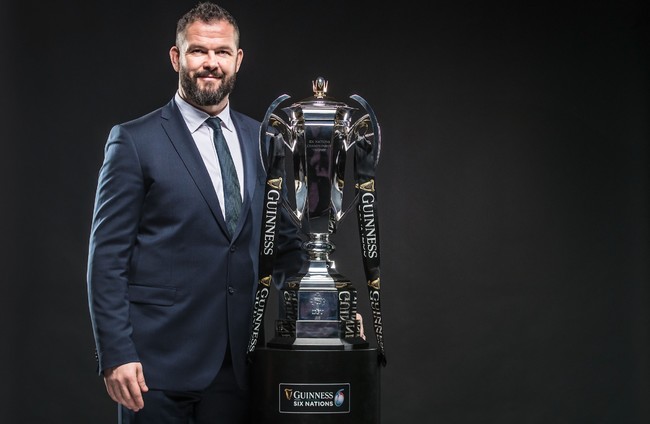STEVE STAUNTON HAD a four-year plan. It’s worth remembering that. Across codes, across the channel, Philippe Saint-André typed ‘de gaffer’ into Google-translate and implemented a similar policy of his own.
Look how that turned out. France were just after controversially losing the 2011 World Cup final by a point when Saint-André arrived, promising stability, delivering chaos. Under his watch, France finished fourth, sixth, fourth and fourth in successive Six Nations championships, their worst run in the competition since the 1950s.
And yet it didn’t seem to bother him on the eve of the 2015 World Cup, when he bullishly stated his four-year rebuilding plan was coming to fruition. “I believe, I really, really believe that France can beat any team in the world,” he said. “Seriously, honestly, yes I do.” They lost 62-13 to New Zealand in the quarter-finals.
There’s a lesson there, not just for Andy Farrell, but every Irish fan obsessed with four-year cycles and sacrificing this year’s Six Nations championship for the long-term goal of building towards 2023. For some time, winning a World Cup quarter-final has been an obsession in this country; no one yet able to crack the code.
Plenty of comment-posters and tweeters are willing to advise Farrell how to do it, however, noting the 19 uncapped players’ in France’s squad for this year’s Six Nations, wondering whether this is the road Ireland should also travel.
Well, it’s not. Remember it’s just eight years since Saint-André looked at the star-studded squad who had turned on his predecessor, Marc Lièvremont, and decided it was time to invoke the spirit of 1789 by getting out an axe of his own.
By the time the 2015 World Cup had come around, there were only seven survivors from the previous tournament. But the radical manifesto failed.
It always does in rugby. You only have to trace your fingers through history’s notepad to realise this; a recurring theme running through each of the team-sheets from the last five World Cup finals.
From England in 2003 through to South Africa last year, every winning side has been led by grey-beards; Clive Woodward selecting six players aged 30 or over to start the 2003 final, the same number of thirtysomethings who lined out for the All Blacks in the 2015 decider. In 2011, New Zealand had five starters aged 30 or over; South Africa getting by with just two (Percy Montgomery and Os du Randt) for the 2007 final and just three (Willie le Roux, Duane Vermeulen and Tendai Mtawarira) in last year’s win over England.
Youth also featured in all those teams but not as prominently. Of the 75 winning players picked to start the last five World Cup finals, just 12 were aged 24 or younger, whereas 41 were in the 25-29 age bracket, with 22 players selected who had 30 or more candles on their birthday cakes. Memo to Farrell: don’t discard experience too quickly.
He hasn’t. The new coach’s squad is noteworthy for the disappearance of 12 names who Joe Schmidt brought to Japan but when you look a little closer at those who’ve been ditched, only one – Rob Kearney – started the quarter-final. The rest were fringe players, or – in Rory Best’s case – have retired.
You can’t predict the future and categorically state whether Farrell is doing the right thing. You can look to the recent past, though, and the templates used by the last five teams to win a World Cup. Each managed to get the right mix, Clive Woodward giving a third of his winning team their debuts in the four-year cycle leading up to the 2003 tournament.
Next came South Africa in 2007. Again, there was a blend of experience and youth; two-thirds of the starting XV capped prior to the previous World Cup, the remaining five players aged 24 or younger.
Onto New Zealand, 2011. Graham Henry started his planning for that tournament three years in advance, first capping Kieran Read, Richard Kahui and Cory Jane in 2008, Owen Franks a year later, Sam Whitelock, Israel Dagg and Aaron Cruden in 2010. All seven started the 2011 final.
Here is firm evidence of a four-year cycle working yet only when you concede that Henry made change and continuity rhyme – for alongside the seven new guys were eight experienced ones: Brad Thorn was 36-years-old when picked to start that 2011 final; Kevin Mealamu was 32; Richie McCaw 31; Conrad Smith and Tony Woodcock were 30; Ma’a Nonu 29; Piri Weepu and Jerome Kaino both 28.
Seven of that team – plus an injury-free Dan Carter – survived to start the next World Cup final, backed up by six guys who made their international debut in the intervening years. In 2019, South Africa didn’t have one player aged under 25 in their starting XV but a third of their side were brought into the squad in the aftermath of 2015.
The secret is going for a cocktail of new and old. You can’t have one or the other, particularly in Ireland’s case where there are only four professional sides – and, at most, a handful of players operating outside the country who could reach international standard.
Aside from anything else, another point has to be made, namely that with just three grand slams to our name and just four championships since 1985, we haven’t earned the right to be sniffy about a tournament as established as the Six Nations. And that’s before we mention how Irish rugby’s financial structure is practically dependent on the national team doing well in it.
So stand firm, Andy Farrell. You can listen to the accusations your predecessors were too conservative and respond by pointing out that James Ryan, Iain Henderson, Robbie Henshaw, Andrew Porter, Jacob Stockdale, Jordan Larmour, Keith Earls and Garry Ringrose were 21 or younger when first capped.
You could ditch Sexton, Earls and Conor Murray now on account of their age but could end up regretting it in four-weeks, never mind four-years-time. People were right to say Schmidt was too slow to promote Larmour and one of Sean Cronin/Niall Scannell ahead of Kearney and Best at the last World Cup. So, don’t repeat that type of mistake.
But when the revolutionary versus evolutionary debate ends in the theoretical chamber, there can be only one winner. Forget a four-year plan. Stick to an 80-minute one.















I don’t condone racist comments in any shape or form but a person cannot be imprisioned for a racist comment. it is disgraceful what was said but at the end of the day that person has the right to his opinion even if it is a disgusting one. the best thing that can be done is the comment removed and the person in question should be banned from games by the club.
Are you familiar with “Prohibition of Incitement To Hatred Act (1989)” – http://www.irishstatutebook.ie/1989/en/act/pub/0019/print.html ? It has been used to charge and imprison people who have made racist comments though it doesn’t appear to have been successfully prosecuted where the comments were made online.
We need to smash racism wherever we see it. Disgusted at some of the casual acceptance of this kind of behaviour.
Racism is blown out of proportion in this country.. simply ignoring it in cases like this is the best thing to do. If this was left go a few twitter followers of this person would have been the only people to see it.. now with the publicity attached hundreds of thousands of people have seen it.
I’m glad the racists have been exposed and hopefully banned from Shamrock Rovers. Racism needs to be nipped in the bud because it spreads among idiots very quickly. Shamrock Rovers fans take enough stick without having a racist label attached to them.
I’m glad the racists have been exposed and hopefully banned from Shamrock Rovers. Racism needs to be nipped in the bud because it spreads among idiots very quickly. Shamrock Rovers fans take enough stick without having a racist label attached to them because of a few uneducated simpletons.
Heard you the first time WS
Politicians should also be called to answer if they contribute to racist incitement
I dont agree with the tweet, dont even know who the player is, but being racist on the internet shouldnt be a crime. Get the post deleted …..problem solved.
all cars should be blue……..
@ stephen : just because it’s the internet doesn’t give you license to be a racist p$&#k , why should you be allowed to abuse people from behind a keyboard and once it’s deleted ‘everything is grand again’ ??
The gas part is, if the fan said it to the players face AND kicked the sh1ite out of him – nothing would have happened!! But be racist online?! Oh god forbid…
Mr Hamstrings, have you ever heard of the word “Assault”?
You can’t just pretend a racist comment didn’t happen once it has been deleted! Imagine how the player feels about an insult like that being thrown at him? If club officials ignored it, it would be adding insult to injury.
Imagine how the player feels now with it going out on every news wire in the country. Its a horrible comment, but the media now add serious injury to insult.
Agreed that its a horrible comment and would probably be better for the guy if it wasn’t in the public eye but it HAD to be reported to the Guards.
Without a doubt. No question of reporting it to the guards.
You have to laugh at the people saying delete it and it’s grand. Funny how they’re all white. You do realise the lad who received this tweet is black? Do you think he’s sitting at home going, “ah sure, he deleted it, I feel ok now”? Racism is not something to be swept under the carpet, the people who are saying we should do that obviously have no clue what it’s like to be discriminated against. Racism is not an opinion, it’s disgusting bigotry and it harms the victim or victims. Extreme levels of naivety from some people.
Here mick Lennon I was in tallagh stadium not so long ago and I’ve heard rovers fans abuse Gilbert in clear ear shot of stewards and it has been let go so about time they got caught and hopefully get prosecuted !
also a further point, any abuse that Gilbert has received during games were due to his ability as a footballer and had nothing to do with the colour of his skin
i dont know what you mean?
could have been a bohs supporter tweeted it
Same old rovers always trying to blame someone else, your club has seen the tweet, anyone that follows football in Ireland can see the tweet, and the person that posted it had rovers comments on their page going back a couple of months. There is even screen shots to prove them. Take the blame for once and stop trying to deflect the fact that the club has racist problems that have been going on for a number of years.
Gilbert should feel worse about his “performances” this year rather than this one incident…also its sad that LOI articles are constantly put up on this site, but only this one, a bad new story, has attracted significant attention and comment
Ok sort the racist thing out and them deport him
this all stems from the racist remarks made in the UK.
some journalist has seen the tweet and now is spinning it to try and make an Irish version of the story..
God save us with this over the top control of what individuals do.. the racist like tweet reference say that the person involved shows poor judgement of their view of the world and others in it if it is in fact a genuine poster and not a journalist running a scam for headlines sake….
Either way I’m not sure my non white colleges will give the comment as much thought as farting in private…. The comment deserves as much attention as that… Now can we all get on with our lives as we always have done…..
When it’s Bohs, Pat’s or anyone else there’s a serious racism problem among League of Ireland fans.
When it’s Rovers it’s just a silly schoolgirl whose actions shouldn’t represent the rest of the fans.
Rovers have handled it awfully going so public with it. It’s gone from doing the rounds among rival forums and being a bit of slagging ammo to becoming a national news story. Why did they feel the need to???
For what it’s worth I don’t think there is a racism problem in the LOI. When the issue of race does crop up it is usually Rovers though. Monkey Chants at Joey Ndo in Dalymount, Nazi salutes in front of their flag on European away trips, Turner and Zayed and the reaction to that incident.
That’s also not to say that all Rovers fans are racists. To do so would be as bigoted as the racist comments themselves.
There are rumours that Gilbert gave a thumbs down whist holding the crest of his jersey and made wa**er gestures towards a section of Rovers fans during the cup final on Saturday.
I would bet money that the girl in question sent that tweet in the heat of the moment from her phone right when that happened.
I don’t condone it or any racism for a second, I’m merely pointing out that that’s the problem with the likes of Twitter being so accessible.
The correct thing to do would have been to privately send a copper (I’m sure there’s at least one Rovers fan policeman) round to her house and put the absolute fear of god into her. I’m sure the Rovers fans more so than the club itself have their own way of weeding out racists.
did you send it Dave,your being very defensive and blaming rovers,sounds like your trying to deflect the spotlight from bohs fans and have innocent rovers fans tarnished
so much for freedom of speech.
So your a racist now Father